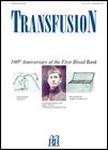版权所有:内蒙古大学图书馆 技术提供:维普资讯• 智图
内蒙古自治区呼和浩特市赛罕区大学西街235号 邮编: 010021

作者机构:Univ Washington Dept Lab Med Seattle WA 98102 USA Stanford Hlth Care Stanford Med Stanford Hosp Transfus Serv Stanford CA 94305 USA Stanford Hlth Care Stanford Blood Ctr Stanford Med Stanford CA USA Stanford Univ Dept Pathol Sch Med Stanford CA 94305 USA
出 版 物:《TRANSFUSION》 (输血)
年 卷 期:2018年第58卷第7期
页 面:1718-1725页
核心收录:
学科分类:1002[医学-临床医学] 1001[医学-基础医学(可授医学、理学学位)] 10[医学]
主 题:BLOOD transfusion CYTOMEGALOVIRUSES HEALTH programs COMPUTER algorithms CALIBRATION
摘 要:BACKGROUNDThe ordering process at Stanford Health Care involved twice-daily shipments predicated upon current stock levels from the blood center to the hospital transfusion service. Manual census determination is time consuming and error prone. We aimed to enhance inventory management by developing an informatics platform to streamline the ordering process and reallocate staff productivity. STUDY DESIGN AND METHODSThe general inventory accounts for more than 50 product categories based on characteristics including component, blood type, irradiation status, and cytomegalovirus serology status. Over a 5-month calibration period, inventory levels were determined algorithmically and electronically. An in-house software program was created to determine inventory levels, optimize the electronic ordering process, and reduce labor time. A 3-month pilot period was implemented using this program. RESULTSThis system showed noninferiority while saving labor time. The average weekly transfused:stocked ratios for cryoprecipitate, plasma, and red blood cells, respectively, were 1.03, 1.21, and 1.48 before the pilot period, compared with 0.88, 1.17, and 1.40 during (p=0.28). There were 27 (before) and 31 (during) average STAT units ordered per week (p=0.86). The number of monthly wasted products due to expiration was 226 (before) and 196 (during) units, respectively (p=0.28). An estimated 7 hours per week of technologist time was reallocated to other tasks. CONCLUSIONAn in-house electronic ordering system can enhance information fidelity, reallocate and optimize valuable staff productivity, and further standardize ordering. This system showed noninferiority to the labor-intensive manual system while freeing up over 360 hours of staff time per year.